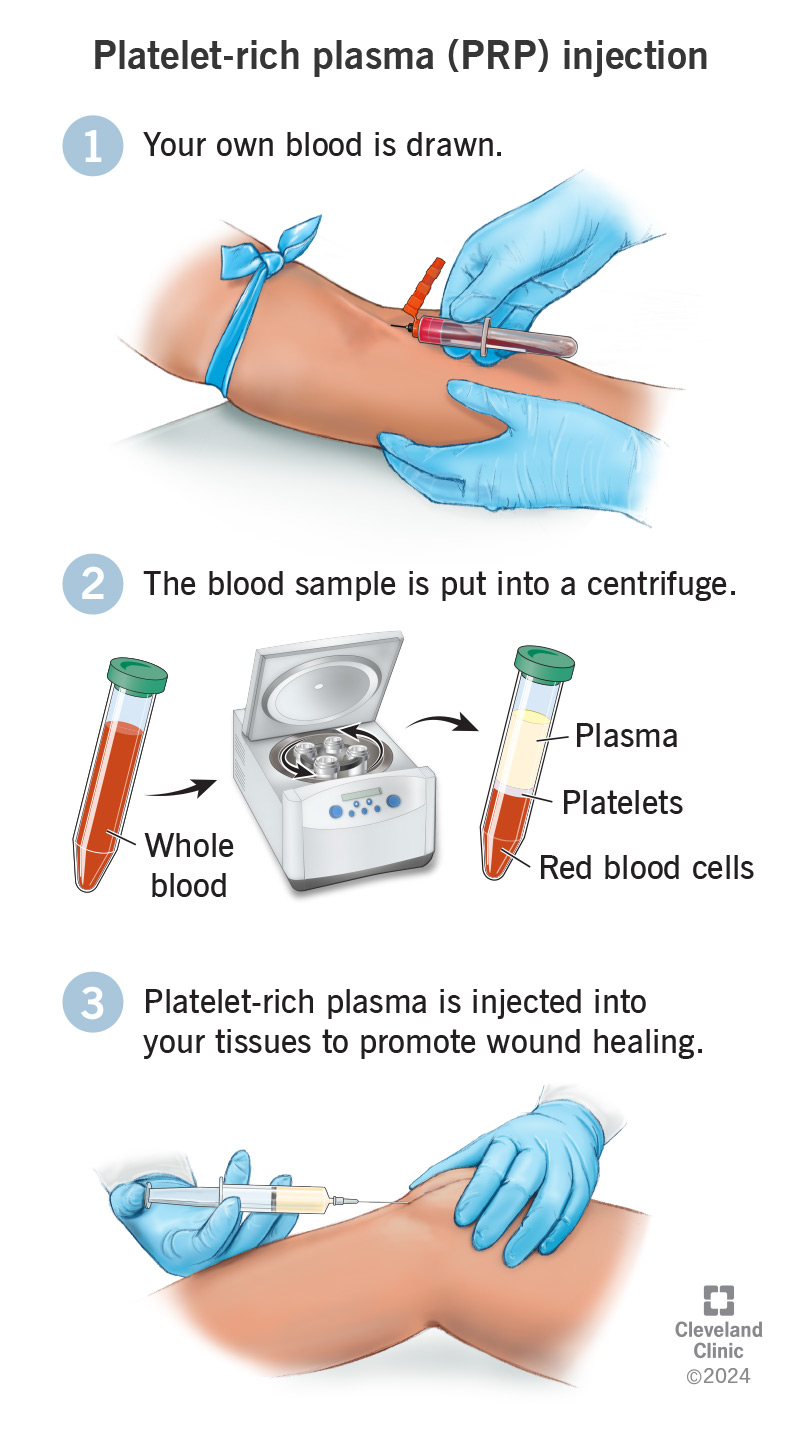Platelet-rich plasma comes from your own blood. Healthcare providers process your blood to concentrate the number of platelets in the plasma and then inject it back into your body. The platelets have healing properties. A PRP injection can offer therapeutic benefits for musculoskeletal injuries and diseases that resist healing.
Advertisement
Cleveland Clinic is a non-profit academic medical center. Advertising on our site helps support our mission. We do not endorse non-Cleveland Clinic products or services. Policy

A PRP (platelet-rich plasma) injection is a therapeutic treatment derived from your blood. Platelets are a component of your blood. They contain special proteins called growth factors that have healing properties. Plasma is the liquid part of your blood. Healthcare providers prepare PRP by processing a sample of your blood in a machine. It separates the platelets and concentrates them in the plasma.
Advertisement
Cleveland Clinic is a non-profit academic medical center. Advertising on our site helps support our mission. We do not endorse non-Cleveland Clinic products or services. Policy
A PRP injection has five to 10 times as many platelets as a normal blood sample would. Healthcare providers inject this platelet-rich plasma into diseased or injured tissues. The growth factors in the platelets may aid in improving your symptoms. They can also lead to faster wound healing. Platelet-rich plasma injections can ease the pain of osteoarthritis and can even treat skin conditions and hair loss.
Your healthcare provider might ask you to stop taking certain medications before your PRP injection, such as blood thinners or NSAIDs. They’ll also want to review your health history to make sure the treatment is safe for you. If you have certain blood conditions, you may not be a good candidate for PRP injections.
The procedure can vary depending on what you’re treating, but most of the steps are the same.
Your provider will:
Advertisement
If you’re getting a therapeutic PRP injection to treat a joint or injury, the whole process takes about an hour. If you’re having a cosmetic microneedling procedure, like a PRP facelift or hair loss treatment, extra steps may make the procedure longer. Your healthcare provider can tell you what to expect.
Research suggests PRP injections can encourage healing in tissues that have been slow or resistant to it.
They might do this by:
PRP injections have very few risks. There’s a remote chance of contamination if a healthcare facility fails to keep your blood sterile while preparing your platelet-rich plasma. But healthcare facilities have protocols to prevent this. It’s also possible the injection may cause more discomfort than you expect.
Platelet-rich plasma is relatively expensive because of the process involved in producing it. Like other biologics, PRP can’t be mass-produced because it comes from your own body. If you have a chronic condition, you’ll have to weigh the costs of regular treatment against the benefits you experience.
PRP treatment will typically cause some swelling and pain at first. This is because it stimulates a healing process similar to what happens after an injury. Swelling and pain are signs of inflammation, which is the beginning of the healing process. These symptoms may last for a day or two after your treatment.
It can take a few weeks to see or feel the initial results of the treatment, like pain relief or cosmetic improvement. It might take several months for injured or diseased tissues to fully heal, or for new hair to grow. Some people may need more than one PRP treatment to achieve the results they’re looking for.
The effects of a PRP injection may last for six months to a year or longer, depending on your condition. During this time, your symptoms should continue to improve for several months. Besides providing temporary pain relief, platelet-rich plasma should improve your overall condition as time goes on.
While some people experience benefits from PRP injections, others don’t. Healthcare providers aren’t sure why these results vary. So, they can’t predict with certainty that PRP therapy will work for you. But if you have a condition that’s difficult to treat and not going away, you might find it worthwhile to try it.
Advertisement
Research on PRP therapy is still in relatively early stages, and the results are mixed. One possible reason for this is that there’s no one standardized process for preparing platelet-rich plasma. So, different PRP products have different compositions. For example, the density of platelets in the plasma can vary.
Scientists are still experimenting with different PRP formulas to treat different conditions. Sometimes, they include a certain number of white blood cells in the plasma. Sometimes, they adjust the density of clotting factors in the plasma. These are the proteins in platelets that make your blood clot.
Healthcare providers who offer platelet-rich plasma injections generally offer them as a useful adjunct therapy. That means they might be a helpful addition, but they shouldn’t be your only treatment. Some providers combine PRP shots with other therapeutic injections, like cortisone shots or gel shots for arthritis.
Healthcare providers are still figuring out the best ways to use platelet-rich plasma to treat different conditions. It’s not an exact science yet, but many providers feel positive about the benefits it may provide. PRP injections treat conditions that are typically long-lasting and difficult to treat. If you’ve struggled to find relief from your persistent symptoms, you may find hope in PRP treatment, too.
Advertisement
Cleveland Clinic’s primary care providers offer lifelong medical care. From sinus infections and high blood pressure to preventive screening, we’re here for you.

Last reviewed on 12/22/2024.
Learn more about the Health Library and our editorial process.